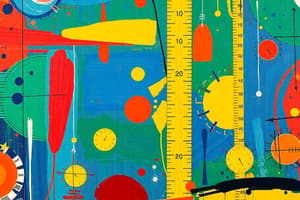Podcast
Questions and Answers
Which of the following is an example of a physical quantity?
Which of the following is an example of a physical quantity?
- Emotions
- Feelings
- Mass (correct)
- Happiness
What is required to express measurements?
What is required to express measurements?
- Comparison with non-physical quantities
- A reference to feelings
- A description of emotional states
- A unit and the magnitude of the quantity (correct)
What does 'P.Q = mag. × unit' represent?
What does 'P.Q = mag. × unit' represent?
- The formula for expressing physical quantities (correct)
- The relationship between physical and non-physical quantities
- The equation for converting units
- The definition of measurement
Which of the following best describes a non-physical quantity?
Which of the following best describes a non-physical quantity?
What is the basic reference standard for measuring time?
What is the basic reference standard for measuring time?
Flashcards
What is Mass?
What is Mass?
The measure of an object's resistance to acceleration when a force is applied.
What is required to express measurements?
What is required to express measurements?
Measurements require both a unit (e.g., meter, second) and the magnitude (numerical value) of the quantity.
What does 'P.Q = mag. × unit' represent?
What does 'P.Q = mag. × unit' represent?
The formula 'P.Q = mag. × unit' represents how physical quantities are expressed, as the magnitude multiplied by the unit.
What is a non-physical quantity?
What is a non-physical quantity?
Signup and view all the flashcards
What is the base unit of time?
What is the base unit of time?
Signup and view all the flashcards
Study Notes
Physical and Non-Physical Quantities
- Physical quantities can be measured using instruments. Examples include:
- Mass
- Length
- Time
- Current
- Non-physical quantities cannot be measured. Examples include:
- Feelings
- Emotions
Measuring Physical Quantities
- Measurement compares a physical quantity to a basic reference standard, called a unit.
- Common units include 1 meter (m), 1 kilogram (Kg), and 1 second (s).
- Expressing a measurement requires both:
- Unit
- Magnitude (value) of the quantity - how many times the unit is contained in the quantity
- Physical Quantity (P.Q) = Magnitude (m) × Unit (u)
Studying That Suits You
Use AI to generate personalized quizzes and flashcards to suit your learning preferences.




